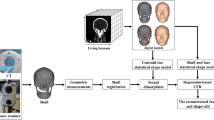Abstract
Craniofacial reconstruction aims to estimate an individual’s facial appearance from its skull. It can be applied in many multimedia services such as forensic medicine, archaeology, face animation etc. In this paper, a statistical learning based method is proposed for 3D craniofacial reconstruction. In order to well represent the craniofacial shape variation and better utilize the relevance between different local regions, two tensor models are constructed for the skull and the face skin respectively, and multi-linear subspace analysis is used to extract the craniofacial subspace features. A partial least squares regression (PLSR) based mapping from skull subspace to skin subspace is established with the attributes such as age and BMI being considered. For an unknown skull, the 3D face skin is reconstructed using the learned mapping with the help of the skin tensor model. Compared with some other statistical learning based method in literature, the proposed method more directly and properly reflects the shape relationship between the skull and the face. In addition, the proposed method has little manual intervention. Experimental results show that the proposed method is valid.






Similar content being viewed by others
References
Berar M, Desvignes M, Bailly G, Payan Y (2005) 3D statistical facial reconstruction. Image and signal processing and analysis. ISPA, pp 365–370
Berar M, Desvignes M, Bailly G, Payan Y (2006) 3d semi-landmark-based statistical face reconstruction. CIT 14(1):31–43
Berar M, Tilotta FM, Glaunes JA, Rozenholc Y (2011) Craniofacial reconstruction as a prediction problem using a Latent Root Regression model. Forensic Sci Int 210:228–236
Claes P, Vandermeulen D, De Greef S, Willems G, Suetens P (2006) Craniofacial reconstruction using a combined statistical model of face shape and soft tissue-depths: methodology and validation. Forensic Sci Int 159(1):147–158
Claes P, Vandermeulen D, De Greef S et al (2006) Statistically deformable face models for cranio-facial reconstruction. CIT 14(1):21–30
Claes P, Vandermeulen D, De Greef S et al (2010) Computerized craniofacial reconstruction: conceptual framework and review. Forensic Sci Int (201):138–145
Claes P, Vandermeulen D, De Greef S et al (2010) Bayesian estimation of optimal craniofacial reconstructions. Forensic Sci Int 201:146–152
Geenens G (2011) Curse of dimensionality and related issues in nonparametric functional regression. Stat Surv 5:30–43
Hu Y, Duan F, Yin B et al (2012) A hierarchical dense deformable model for 3D face reconstruction from skull. Multimedia Tools Appl. doi:10.1007/s11042-012-1005-4
Huang D, Duan F, Deng Q et al (2011) Face reconstruction from skull based on partial least squares regression. CIS:1118–1121
Jones MW (2001) Facial reconstruction using volumetric data. In: Ertl T, Girod B, Niemann H, Seidel H-P (eds) Proceedings of the Sixth International Vision Modelling and Visualisation Conference—VMV-01, Stuttgart, November 21–23, pp 135–150
Kahler K, Haber J, Seidel H-P (2003) Reanimating the dead: reconstruction of expressive faces from skull data. ACM Trans Graph 22(3):554–561
Lei Z, Bai Q, He R et al (2008) Face shape recovery from a single image using CCA mapping between tensor spaces. CVPR
Lorensen WE, Cline HE (1987) Marching cubes: a high resolution 3D surface construction algorithm ACM SIGGRAPH. Comput Graph 21(4):163–169
Michael S, Chen M (1996) The 3D reconstruction of facial features using volume distortion. In: Proc. 14th Eurographics UK Conference, pp 297–305
Paysan P, Albrecht T (2009) Face reconstruction from skull shapes and physical attributes. Lect Notes Comput Sci 5748:232–241
Pei Y, Zha H, Yuan Z (2008) The craniofacial reconstruction from the local structural diversity of skulls. Comput Graph Forum 27(7):1711–1718
Quatrehomme G (1997) A fully three-dimensional method for facial reconstruction based on deformable models. J Forensic Sci 42(2):649–652
Rana S, Liu W, Lazarescu M et al (2009) A unified tensor framework for face recognition. Pattern Recog 42:2850–2862
Tilotta F, Glaunès J, Richard F, Rozenholc Y (2010) A local technique based on vectorized surfaces for craniofacial reconstruction. Forensic Sci Int 200(1–3):50–59
Tu PH, Book R, Liu X et al (2007) Automatic face recognition from skeletal remains. CVPR’2007
Vanezis P, Vanezis M, Mccombe G, Niblet T (2000) Facial reconstruction using 3-D computer graphics. Forensic Sci Int 108:81–95
Vasilescu MAO, Terzopoulos D (2003) Multilinear subspace analysis of image ensembles. CVPR 2:93–99
Wikipedia (2011) Frankfurt plane. The Wikimedia Foundation, IncWeb. http://en.wikipedia.org/wiki/Frankfurt_plane. Accessed 21 Aug 2011
Wilkinson C (2004) Forensic facial reconstruction. Cambridge University Press, Cambridge
Wold S, Kettaneh-Wold N, Skagerberg (1989) B Non-linear PLS modelling. Chemometr Int Lab Syst 7:53–65
Acknowledgments
This work was partially supported by the National Natural Science Foundation of China (Nos. 61272363, 61171169, 61003133), National High-Tech Research and Development 863 Plan of China (No. 2008AA01Z301).
Author information
Authors and Affiliations
Corresponding author
Rights and permissions
About this article
Cite this article
Duan, F., Yang, S., Huang, D. et al. Craniofacial reconstruction based on multi-linear subspace analysis. Multimed Tools Appl 73, 809–823 (2014). https://doi.org/10.1007/s11042-012-1351-2
Published:
Issue Date:
DOI: https://doi.org/10.1007/s11042-012-1351-2




